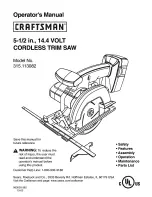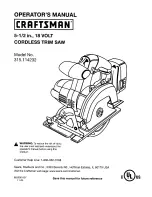
9
Maintaining maximum cutting capacity (Fig. 12 &
13)
Unplug the tool before any adjustment is attempted.
This tool is factory adjusted to provide the max. cutting
capacity for a 210 mm saw blade. When the diameter of
the blade has been reduced due to sharpening, use a
screwdriver to adjust the depth adjusting screw. By turn-
ing the depth adjusting screw counterclockwise, you can
obtain wider max. cutting capacity. Adjust so that when
the handle is in the fully lowered position, there will be a
distance of about 130 mm from the front face of the guide
fence to the point where the front edge of the blade
enters the kerf.
With the tool unplugged, rotate the blade by hand while
holding the handle all the way down. Be sure that the
blade does not contact any part of the lower base when
the handle is lowered completely.
Positioning for adjusting the miter angle (Fig. 14
& 15)
Loosen the screw on the guide fence. Hold down the
base and move the handle to turn the turn base until the
pointer on the base indicates the desired angle on the
turn base. Then tighten the screw on the guide fence to
secure the turn base.
CAUTION:
When turning the turn base, be sure to raise the handle
fully.
Securing workpiece (Fig. 16 & 17)
WARNING:
It is extremely important to always secure the workpiece
properly and tightly with the vise. Failure to do so can
cause the tool to be damaged and/or the workpiece to be
destroyed. PERSONAL INJURY MAY ALSO RESULT.
Also, after a cutting operation, DO NOT raise the blade
until the blade has come to a complete stop.
Secure the turn base firmly at the position of the desired
miter angle. Position the vise arm according to the thick-
ness and shape of the workpiece and secure the vise
arm by tightening the wing bolt. Press the workpiece flat
against the guide fence and the turn base. Position the
workpiece at the desired cutting position and secure it
firmly by tightening the clamp screw.
When the workpiece is long (i.e., more than half the
workpiece overhangs the base), use the holder (standard
equipment) or other supports that are as high as the top
surface of the adjusting plate.
To install the holder on the base, raise the left side of the
base slightly and insert the holder into the slot in the
base.
Adjust the knob so that the holder is flush with the top
surface of the adjusting plate.
Operation (Fig. 18)
1.
When cutting with this tool, the thickness of the
blade is cut out of the workpiece as well. Therefore,
your cutting line should be on either the left or right
side of the groove in the kerf board.
2.
For tools with lock lever
Switch on the tool and wait until the blade attains full
speed. Pull the lock lever at the side of the handle
and then lower the blade gently into the cut.
For tools without lock lever
Switch on the tool and wait until the blade attains full
speed. Then lower the blade gently into the cut.
3.
When the blade contacts the workpiece, gradually
bear down on the handle to perform the cut.
4.
When the cut is completed, switch off the tool and
WAIT UNTIL THE BLADE HAS COME TO A COM-
PLETE STOP before returning the blade to its fully
elevated position. A thin piece of cut off material
could otherwise contact the coasting blade and be
thrown around dangerously.
Fence plate (Fig. 19)
The fence plate is designed to prevent smaller cutting
scraps from jamming inside the blade base. The fence
plate moves right or left automatically as the turn base is
rotated.
Alignment for squareness
This tool was carefully adjusted and aligned for square-
ness of cut at the factory, but rough handling may have
affected the alignment. If your tool is not aligned properly,
perform the following.
Lower the handle and make sure that the blade is cen-
tered in the middle of the kerf board. If the lowered blade
is off center, the arm is not aligned properly. Gently lay
the tool back to expose the underside of the turn base.
Loosen the three bolts holding the arm with the hex
wrench and leave them in a semi-tightened condition.
Adjust the arm so that the lowered blade is centered in
the middle of the kerf board. Then tighten the bolts clock-
wise to secure the arm.
(Fig. 20)
Return the tool to its normal, upright position. Loosen the
four bolts holding the guide fence and leave them in a
semi-tightened condition. Turn the turn base so that 0°
graduation on the turn base is aligned with the pointer on
the base.
(Fig. 21)
Square the side of the blade with the face of the guide
fence using a triangular rule, try-square, etc. Then
tighten the bolts on the guide fence securely, making
sure that the steel ball on the turn base exactly fits the
hole in the underside of the guide fence.
(Fig. 22)
Adjusting the adjusting plate (Fig. 23 & 24)
Place the tool on a level table or work bench with the left
end of the base protruding from the table or work bench
surface. Loosen the screws (A) holding the adjusting
plate and leave them in a semi-tightened condition.
Place the ruler on the turn base and adjust the adjusting
plate by turning the screws (B) with a screwdriver so that
the top surface of the adjusting plate is flush with the sur-
face of the turn base. Then tighten the screws (A)
securely to secure the adjusting plate.
Carrying tool (Fig. 25)
When carrying the tool, raise or lower the handle fully
and press the stopper pin to lock the handle in the raised
or lowered position. Also secure the turn base by tighten-
ing the screw on the guide fence.
Содержание LS0810
Страница 2: ...2 1 2 3 4 5 6 7 8 8 17 2 16 15 14 13 11 12 9 10 7 6 7 8 5 1 3 2 4 3 2 1 ...
Страница 3: ...3 9 10 11 12 13 14 15 16 31 30 23 32 29 28 23 3 27 26 25 24 22 23 21 18 19 20 ...
Страница 4: ...4 17 18 19 20 21 22 23 24 45 43 34 44 25 43 34 42 26 41 41 28 23 26 20 39 36 38 37 33 34 35 ...
Страница 5: ...5 25 26 27 48 25 47 46 27 ...
Страница 19: ...59 ...
Страница 20: ...Makita Corporation Anjo Aichi Japan 883597D949 ...






































